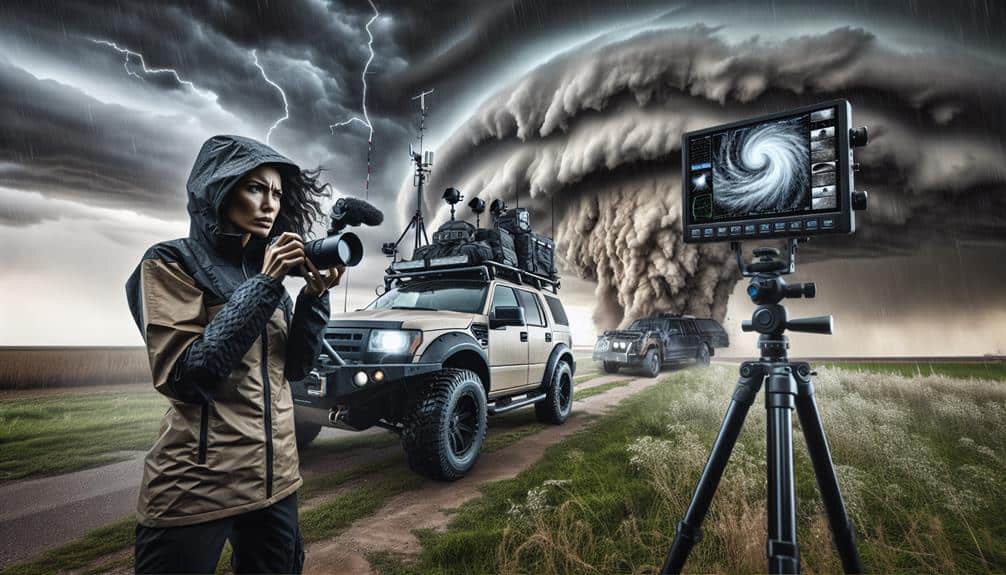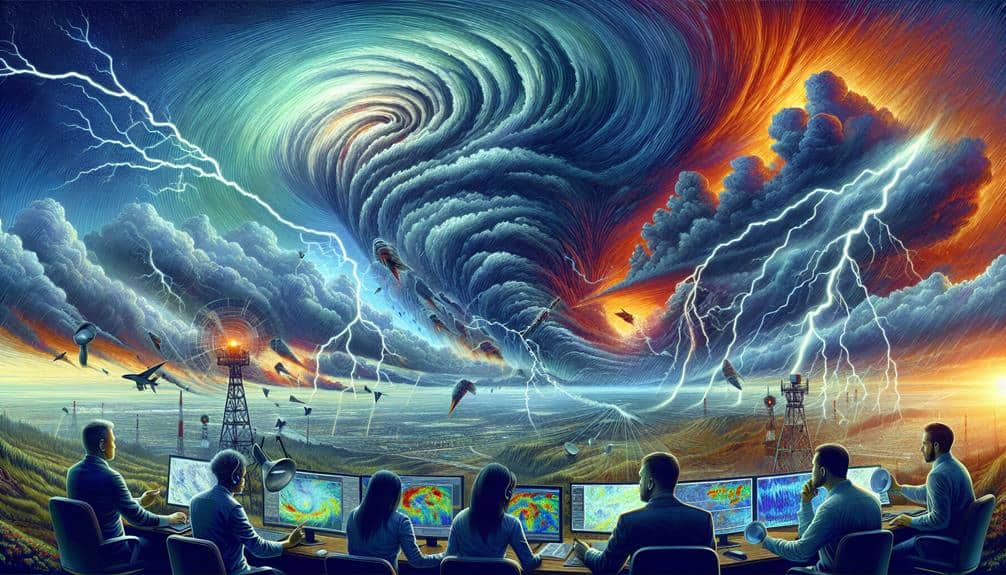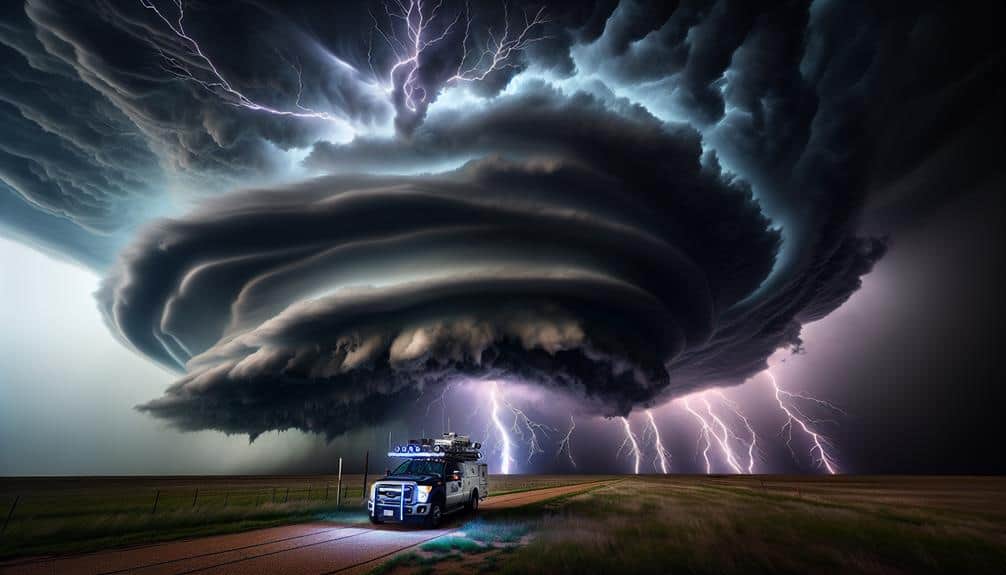We chase supercells to capture the awe-inspiring drama and unpredictable beauty of nature's fiercest storms. Every chase combines meticulous planning, top-tier camera gear, and a deep passion for experiencing raw power firsthand. We use wide-angle lenses to frame the vast, dynamic skies and telephoto lenses to capture intricate storm details. The adrenaline rush propels us to navigate treacherous conditions while waiting patiently for those fleeting moments that define photographic masterpieces. Safety is paramount, demanding constant vigilance and readiness. Our commitment to documenting these epic phenomena is unwavering, offering a glimpse into an electrifying world only few witness. For more insights, explore our storm-chasing adventures.
Key Points
- Photographers seek to capture the raw power and unpredictability of supercells for breathtaking shots.
- Dynamic skies and intense weather provide unique opportunities for dramatic and awe-inspiring photography.
- Supercells offer fleeting moments of powerful beauty, perfect for creating photographic masterpieces.
- The adrenaline rush and thrill of chasing extreme weather draw photographers to supercells.
The Allure of Supercells
There's something inherently alluring about supercells that draws photographers like us into their turbulent embrace. The raw power and sheer unpredictability of these storms ignite our photography passion, compelling us to chase them across vast plains and open skies.
As storm chasers, we live for that adrenaline rush, the thrill of the hunt, and the promise of capturing nature's most formidable spectacles.
Supercells are the epitome of extreme weather, showcasing the atmosphere's wild and untamed beauty. Their towering, rotating updrafts and menacing cloud structures serve as both a challenge and a source of artistic inspiration.
We're not just documenting a storm; we're seeking the perfect interplay of light, shadow, and motion that transforms chaos into visual poetry.
Every chase demands meticulous planning, from analyzing weather models to selecting vantage points. We navigate through unpredictable terrains, always mindful of safety yet driven by an insatiable desire to witness and immortalize the sublime.
The freedom of the open road, the unpredictability of the skies, and the fleeting moments of breathtaking beauty make each expedition an unforgettable quest. In these encounters, we find not just photographs, but fragments of the sublime.
Capturing Nature's Drama
Every supercell chase demands our utmost dedication to capturing nature's drama in its most intense and raw form. As storm chasers, we live for the electrifying moments when the sky transforms into a theater of dramatic landscapes. The thrill of positioning ourselves just right, under the swirling mesocyclone, is unparalleled. We harness every ounce of our skill to frame powerful imagery that speaks to the untamed spirit of the storm.
To achieve this, we focus on a few critical photography tips.
First, timing is everything. We must anticipate the supercell's movements, ensuring we're in the perfect spot to capture its peak intensity.
Additionally, composition plays a pivotal role. Including foreground elements like a solitary tree or an abandoned barn can add scale and depth to our shots, making the storm appear even more formidable.
Lighting is also a key factor. The interplay between the dark, ominous clouds and the fleeting bursts of lightning creates a dynamic range that's both challenging and rewarding to capture.
Patience and persistence are our allies. Waiting for that perfect moment when nature reveals its raw, unfiltered power is what makes storm chasing so profoundly fulfilling.
Equipment for Storm Photography
When it comes to storm photography, our choice of equipment can make the difference between capturing a fleeting moment of raw beauty and missing it entirely. The right camera gear isn't just about having the latest gadgets; it's about understanding the tools that will let's harness nature's fury with precision and artistry.
First, we need a robust camera body that performs exceptionally well in low light, as storms often brew under dim skies. Full-frame DSLRs or mirrorless cameras are ideal for their superior dynamic range and low-light capabilities.
A sturdy tripod is non-negotiable; it provides the stability required for long-exposure shots, even in gusty winds.
Lenses are our eyes to the storm. Wide-angle lenses, particularly those in the 14-24mm range, allow us to capture the vastness of supercells, while telephoto lenses (70-200mm) can zoom in on mesmerizing details like swirling clouds or lightning bolts.
Don't forget weather-sealed gear to withstand the elements and microfiber cloths to keep lenses clear.
Techniques for Stunning Shots
Mastering the art of storm photography pivots on our ability to utilize techniques that balance the unpredictable power of nature with meticulous control over our camera settings. To capture the raw beauty of supercells, we need to focus on both lighting tips and composition tricks, making each shot a breathtaking tribute to Mother Nature's fury.
First, understanding the dynamic lighting conditions is essential. Storms bring rapidly changing light, so:
- Use a tripod: Stability is key in low light.
- Adjust ISO: Keep it low to avoid noise but flexible enough to handle sudden changes.
- Manual mode: Offers control over shutter speed and aperture, crucial for dramatic skies.
Next, composition tricks can turn an ordinary shot into a masterpiece.
- Rule of thirds: Place the horizon or key elements off-center for balance.
- Foreground interest: Include elements like trees or buildings to add depth.
- Leading lines: Use roads or lightning bolts to guide the viewer's eye.
Safety Precautions
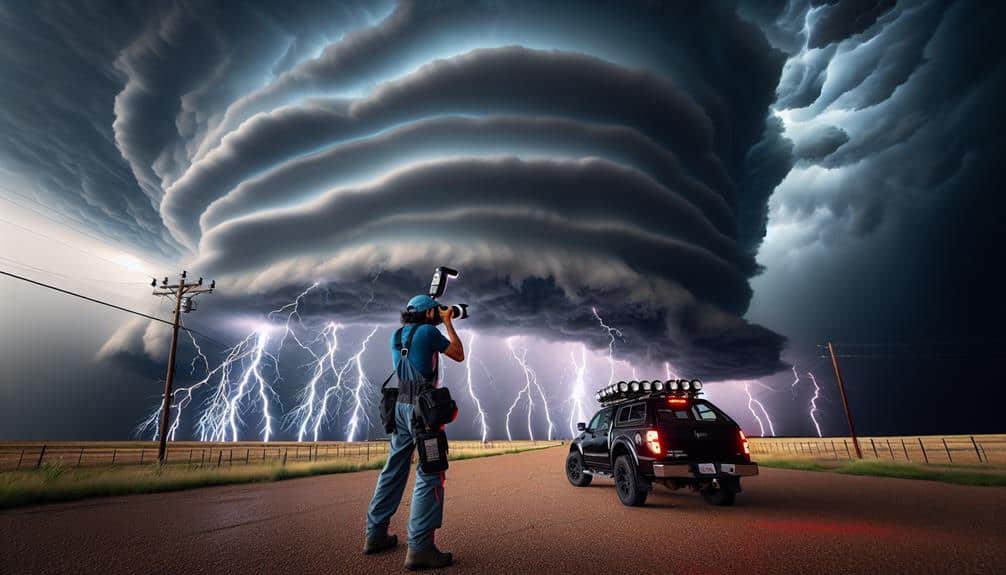
Securing our safety while pursuing supercells demands meticulous planning and a keen awareness of our surroundings. We can't afford to take any risks, so emergency preparedness is our top priority. We start by identifying storm shelters along our planned route—places where we can take cover if conditions become too perilous. Knowing these locations in advance can be life-saving.
Weather monitoring is non-negotiable. We rely on multiple sources for real-time updates: radar apps, National Weather Service alerts, and portable weather radios. This multi-layered approach guarantees we never miss a critical piece of information. We also use GPS trackers to keep tabs on our exact location relative to the storm.
Communication plans are equally essential. We establish check-in times with a designated contact who knows our itinerary. Satellite phones and walkie-talkies serve as backups in case cell towers go down.
Everyone on the team needs to be on the same page, understanding the protocols for different scenarios, from sudden hailstorms to unexpected tornadoes.
The Adrenaline Rush
As we position ourselves on the storm's edge, the thrill of the approaching supercell sends a jolt of exhilaration through our veins. We capture nature's raw fury in each crack of lightning, each swirling vortex, knowing that these moments are both ephemeral and powerful.
The adrenaline fuels our determination to frame the perfect shot, blending technical precision with sheer passion.
Thrill of the Storm
The raw power of a supercell ignites an unparalleled adrenaline rush, driving us to capture the perfect shot amid the chaos of nature's fury. Storm chasing takes us to the edge of the world, where the horizon is dominated by swirling clouds and electrifying lightning. It's not just about extreme photography; it's about feeling alive in the face of nature's raw, unbridled power.
When we commence on a storm-chasing journey, we become part of the storm's narrative. The thrill of the storm isn't just visual; it's visceral. Our senses are heightened, our hearts race, and our cameras become extensions of ourselves, capturing moments that are both fleeting and eternal.
Here are four reasons why this thrill captivates us:
- Unpredictability: Each storm is unique, offering a different challenge and perspective.
- Intimacy with Nature: We witness nature's might up close, feeling the wind and hearing the thunder.
- Technical Mastery: Balancing safety and capturing the perfect shot requires skill and precision.
- Community: Sharing experiences with fellow storm chasers creates a bond over our shared passion.
In the end, storm chasing is more than a hobby; it's a pursuit of freedom, a dance with the elements that leaves us forever changed.
Capturing Nature's Fury
With our hearts pounding and cameras at the ready, we stand poised to capture nature's fury in its most visceral and electrifying moments. There's an undeniable thrill in facing stormy landscapes and dynamic skies, where every bolt of lightning and gust of wind tells a story of intense weather. As photographers, we're driven by the allure of powerful beauty, the kind that commands respect and evokes awe.
We meticulously track supercells, studying weather patterns and radar images, waiting for the perfect combination of elements that will create a photographic masterpiece. The adrenaline rush intensifies as the skies darken and the winds pick up, transforming the horizon into a canvas of swirling clouds and dramatic contrasts.
Each click of the shutter is a race against nature's swift changes, capturing fleeting moments that define the raw power of our environment.
In these storm-chasing adventures, we embrace the freedom to explore and document the untamed forces of nature. The images we capture aren't just photographs; they're testimonies to the grandeur and unpredictability of the natural world. Our quest is to immortalize these tempestuous scenes, sharing their powerful beauty with those who crave the extraordinary.
Stories From the Field
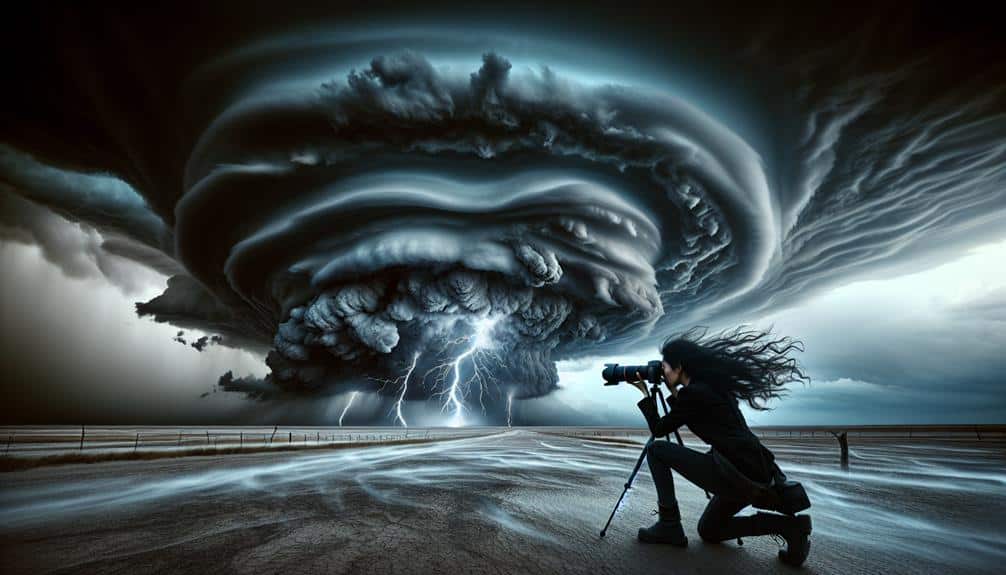
We've braved hailstorms and furious winds to capture the raw, untamed beauty of supercells in their full, electrifying glory. As storm chasers, we find ourselves driven by the allure of unpredictable weather patterns. Each supercell presents unique photography challenges that push us to our limits, both technically and creatively.
One of our most unforgettable experiences involved maneuvering stormy conditions in the Great Plains. The sky turned an ominous shade of green, and the air crackled with electricity. We set up our tripods, adjusting for the low light and rapidly changing focal points. The storm swirled around us, a mesmerizing dance of nature's fury.
Here's what we learned from the field:
- Preparation is key: Always check weather forecasts and have a plan.
- Gear matters: Use durable, weather-sealed cameras and lenses.
- Safety first: Know when to retreat. No shot is worth risking your life.
- Patience pays off: Storms are unpredictable; sometimes you wait hours for the perfect moment.
Each chase is an adventure, a quest for that one perfect shot that embodies the essence of freedom and raw natural power.
Frequently Asked Questions
How Can I Start Learning About Storm Photography?
Let's immerse ourselves in storm photography like eagles soaring in a tempest. We can start with online courses and workshops to build a solid foundation, then gain field experience and practice to truly capture nature's raw power.
What Are the Best Locations for Photographing Supercells?
We love storm chasing in the Great Plains and Tornado Alley. These areas offer extreme weather and ideal conditions for landscape composition. Using advanced photography techniques, we capture the raw power and beauty of supercells.
How Much Does It Cost to Chase Storms for Photography?
Chasing storms costs an arm and a leg, but it's worth every penny. We factor in equipment costs and travel expenses. High-quality cameras, lenses, and safety gear add up, plus gas, lodging, and food during our wild, unpredictable journeys.
Are There Any Weather Apps Useful for Storm Photographers?
For storm tracking and weather forecasting, we rely on apps like RadarScope and Storm Shield. They provide real-time radar data and alerts, helping us capture breathtaking storm shots while embracing the unpredictable freedom of nature.
What Qualifications Do Professional Storm Photographers Usually Have?
Professional storm photographers possess perfected photography skills, significant meteorology knowledge, and steadfast safety precautions. We wield specialized equipment, ensuring every shot showcases the storm's splendor while safeguarding ourselves. Our passion propels us to capture nature's wildest wonders.
